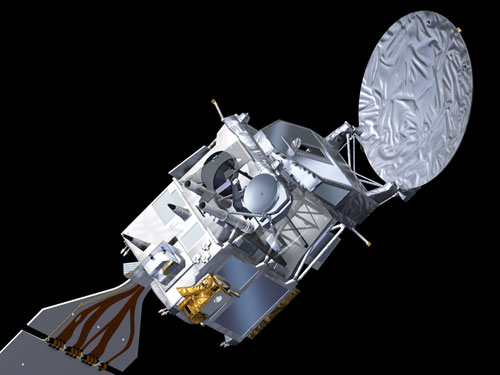- EarthCARE
- Mission
- EarthCARE Overview
Mission Overview
EarthCARE infographic
Learn about ESA’s upcoming cloud, aerosol and radiation explorer mission, EarthCARE, a joint venture between ESA and JAXA, and the most complex Earth Explorer mission developed so far.
The making of EarthCARE
This video describes the design of the upcoming EarthCARE satellite and its instruments, and also demonstrates
the rigorous testing the satellite receives prior to launch.
Satellite Design
The EarthCARE satellite will carry four instruments for observations of clouds and aerosols with four synergistic sensing methodologies.
The three-axis stabilised satellite platform was designed to accommodate the four instruments, which need unobstructed and very accurately collocated views of Earth as well as unobstructed views for solar calibration of the passive instruments.
The satellite design meets these challenges by employing a fully customised carbon fibre-based platform with the radar, lidar and star trackers (used for determining the satellite's attitude) positioned as close together as possible, thereby minimising alignment errors.
The satellite is dominated by the large Cloud Profiling Radar (CPR) antenna, which is 2.5 m across. The long trailing solar panel at the rear gives the satellite an overall length of 17 m. The solar panel is made up of five sections, covers an area of 21 sq m and, at the satellite's low orbital altitude, helps minimise atmospheric drag. The size of the satellite (with solar panel and CPR antenna stowed for launch) and its mass of about 2000 kg plus fuel makes it compatible with both Soyuz and Zenit launchers. EarthCARE has a design lifetime of three years, including a six-month commissioning phase.
Mission Operations
EarthCARE will orbit Earth at an altitude of around 393 km. The altitude needs to be as low as possible to optimise the use of the lidar and radar, but not too low where atmospheric drag would impact fuel consumption and the life of the mission.
Since global coverage is required, EarthCARE's orbit is near-polar. It crosses the equator in the early afternoon, providing optimal illumination and minimal sun glint for the passive instruments.
The system's power demand is significant. The two active instruments, the Atmospheric Lidar (ATLID) and the CPR, require 2500 W.
| Orbit | Routine operations |
|---|---|
| Orbit Type | Sun-synchronous |
| Mean Solar Local Time | 14:00 (descending node) |
| Mean Spherical Altitude | 393.14 km |
| Inclination | 97.05° |
| Repeat Cycle | 25 days/389 orbits |
| Orbital Duration | 5552.7 seconds |
The EarthCARE ground segment consists of the flight operations, data acquisition, archiving and dissemination, and JAXA's ground segment processing the Cloud Profiling Radar data.
ESA's Flight Operations Segment will be in charge of spacecraft and orbit control and on-board software maintenance.
This facility is at ESA's European Space Operations Centre (ESOC) in Darmstadt, Germany. Operations will be conducted via the S-band ground station in Kiruna, Sweden or Svalbard, Norway.
ESA's Payload Data Ground Segment is at ESA's Centre for Earth Observation (ESRIN) in Frascati, Italy and will be responsible for science data acquisition (via X-band downlink), processing and archiving. It will also handle data exchange with the JAXA ground segment and disseminate ESA and JAXA science data products to ESA's data users.
